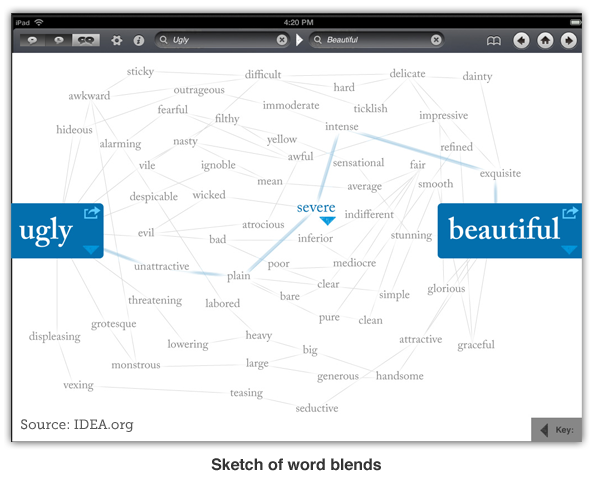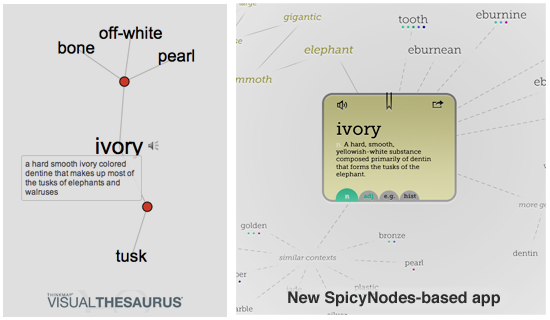The developer of the SpicyNodes mind mapping app for the Apple iPad has announced an ambitious new project that will utilize its underlying technology in a unique way.
IDEA.org seeks to develop the “thesaurus of the future” by combining its SpicyNodes mind mapping technology (click here to read my review of SpicyNodes) with a powerful online dictionary called Wordnik to create a powerful, low-cost dictionary and thesaurus that makes the most of the iPad’s intuitive touch interface.
The developer is also taking a unique approach to funding this project: They seek to raise money to develop it via a popular crowdfunding service called Kickstarter. This is a relatively new model for funding creative projects; in 2011, Kickstarter contributed $67 million to arts projects. You can view the team’s Kickstarter proposal here and follow along on the project’s progress on the IDEA.org blog.
The developers’ mission is to “Inspire millions of people to discover and explore words. This project will build an iPad app for visually browsing and discovering words and the connections between them – and publish it inexpensively or free. The app will be an interactive dictionary and thesaurus in English,” according to its Kickstarter profile.
I was recently contacted by Michael Douma, the leader of this exciting new project. In an e-mail interview, he explains what his development team hopes to create, the unique combination of technologies it will leverage, and some of the innovative features we can hope to see – if they succeed in being able to reach their fund-raising goal (hint: you can help!).
A pledge to help fund this project will enable Douma and his team to work for two months to complete its proposed thesaurus app. Under the Kickstarter funding model, which is an all-or-nothing approach, it needs to achieve a level of US$7500 in funding by the deadline of April 13th.
I encourage you to pledge what you can to support this worthwhile project.
Chuck Frey: What inspired you to create this iPad-based thesaurus?
Michael Douma: Our inspiration for a visual iPad thesaurus app goes back over a decade. For years, I’ve been fascinated with visual representations of knowledge, like mind maps and concept maps. My colleagues and I began working on the web-based SpicyNodes visualization system 8 years ago. Our initial work on SpicyNodes in web browsers used Adobe Flash, but the result was not as intuitive or fluid as we wanted. The Apple iPad opened new horizons. With multi-touch, dragging nodes on the screen is a delight – fast, and smooth. We recently discovered Wordnik, which was founded by Erin McKean and launched in 2009. Erin has created a fantastic database of definitions and related words. This new app pairs our visualization technology from SpicyNodes with the word knowledge of Wordnik.
Frey: What makes it unique compared to other iPad apps?
Douma: No other app allows readers to visually browse words, jumping endlessly from word to word, exploring connections like a mind map.
There are several related projects. Our team currently has an app that makes mind maps out of Wikipedia articles, called WikiNodes. This uses our SpicyNodes visualization technique, which won the 2011 Website for Teaching and Learning award from the American Association of School Librarians (AASL).
There are other apps and web sites from other developers that also use nodes. VisualThesaurus.com (not affiliated with our project) is a web site that works in mobile Safari. They were a pioneer in 1998, but they have lower-quality word definitions, no definitions or etymologies, fewer word connections (often readers reach a dead-end, instead of nearly infinite browsing), and are expensive, charging $3 a month or $20 per year. Encyclopædia Britannica’s app ($24 per year) has a link view of encyclopedic articles, similar to our WikiNodes, but less interactive. Discovr has four apps that use radial layouts for browsing people, apps, music, and movies. The TWIG touch thesaurus ($25-35), released last month, is designed for serious word enthusiasts, and displays semantic relationships (meanings) and syntactical relationships (syntax) as branches, but their app is limited to just one seed word at a time, readers can not jump from word to word.
Another unique aspect of our app is personalization and annotation. Readers can label words with their own tags (e.g., “kind words” or “rhymes with ‘zebra'”), will have customized layouts that group words in their own way, like new branches of a mind map. Users can also annotate any word with text, audio, or video, similar to the new features we released this week in our WikiNodes app.
And there are word blends…
Frey: What are “word blends” and how did you come up with this idea?
Douma: Sometimes a word is just on the tip of your tongue. But what is it? Wouldn’t it be great to be able to find a word which is similar to two other words.
For example, the word for something which is difficult, yet delicate, might be “ticklish;” or both large and handsome could be ‘generous.’ By chaining synonyms together in the app, readers can do this, and also discover a sea of other related words. I first saw a proof-of-concept implementation of this in the work of two Harvard students in 2008 who visualized the connections between words in their project. I think it will be great for brainstorming (see the image below for an idea of one approach to visualizing word blends the developers are considering).
Frey: Is the appeal of your app primarily educational? Who else can benefit from it?
Douma: The app is intended to entice people to explore the various meanings and relationships between words. We are focused on the needs of students and teachers, and we think this will be an awesome, free or inexpensive way to get students thinking about what words mean, and expanding their vocabulary. This can be especially useful for visually-oriented or learning-disabled learners, or new learners of English.
More broadly, we think anything interested in visual thinking and brainstorming will find the visual layouts inspiring and useful. The word constellations, and the word blends in particular, will be a go-to tool for writers, and other professionals who wants to find the right word to express themselves.
A secondary audience is word enthusiasts.
Frey: I’ve used the browser-based Visual Thesaurus before. How is this different or better?
Douma: VisualThesaurus.com was a trailblazing project when they launched nearly 15 year ago, but they have stopped innovating. Their business model is be focused on institutional subscriptions. Our app is:
- An app, not a web site
- Free or very inexpensive
- A richer word source, with great definitions from ‘American Heritage Dictionary of the English Language’, and additional definitions from Wiktionary, WordNet, and others via Wordnik.com. VisualThesaurus.com only has data from WordNet.
- Full definitions for every word, easily selected with tabs.
- Other features, like word blends, over 10 thousand easily confused words, sharing, bookmarking and labels, and a more visually immersive experience.
(see the screen shots below for a visual comparison of SpicyNodes and VisualThesaurus)
Frey: How do you plan to leverage the touch interface of the iPad to create a “wow” experience for users of it?
Douma: The multi-touch iPad interface offers an engaging experience. As we have already done with SpicyNodes and WikiNodes, tapping a node brings it to the center of the screen and displays additional details, such as definitions. Dragging the screen uses sophisticated physics-based algorithms so that all the nodes move and spin on the screen in an intuitive way. It feels like you are really touching and dragging words. Animations are fast and smooth, and text will look especially amazing on the new high-resolution iPad.
Frey: How does the Kickstarter funding work, and why did you choose that route?
Douma: Kickstarter is a leading “crowd-funding” site. They are focused on creative projects that have specific starting and ending dates. Projects are funded in an all-or-nothing manner: We only receive the investment if enough people back our project to meet our target of $7,500 by April 13, 2012.
The exciting thing about crowd-funding is that it allows us to shift the financial burden, from students and schools to donors and backers. By fund-raising upfront, we do not need to recoup as much revenue later, and we can publish the app for free or inexpensively. How often we make the app free will depend on how much the Kickstarter raises.
Frey: Tell me about IDEA.org: Who are you? And how does the development of this app fit in with your mission as an organization?
Douma: IDEA is a nonprofit organization committed to enhancing the public’s literacy of science and culture. We think it is an exciting time for public education, as traditional business models and methods of delivering information to the public are evolving. At IDEA, we try to draw on some of the best practices of museums, publishers, software developers, and research labs. The app directly relates to our mission of literacy because we want more people to be engaged in culture, and understanding and communicating clearly are integral to that. I can’t imagine a more ideal project for IDEA than a visual thesaurus app.
Also, this would only be possible with the great work by the team at Wordnik.
Frey: How can readers of this blog contribute to this worthy project?
Douma: We encourage readers to look at our project on Kickstarter and consider backing it. Any amount is welcome, pledges start at just $1. As a backer, you demonstrate to others that you think the project matters, and will receive updates.
If you pledge $10 or more, you will be credited within the ‘thank you’ section of the app, and will receive behind-the-scenes updates as we develop the app, and be invited to share your input. Higher pledges receive rewards like postcards, coffee mugs, and posters. Also for $50, there’s a fun ‘easter egg’ that you can have your own definitions added to the app if users enter a secret code of your choosing.
Frey: Assuming that your fund-raising campaign is a success, what’s your target date to launch this new app?
Douma: Our target is a July 2012 launch, assuming 2 months of hard work. We already have much of the underlying technology in place from our prior work on SpicyNodes and WikiNodes. And Wordnik’s API is ready for our use.
Frey: Where can readers go to learn more about your progress?
Douma: Our Kickstarter page does a great job of keeping everyone informed. Kickstarter will e-mail backers with updates, too. Also, we will be updating our blog with our progress.




Leave a Reply